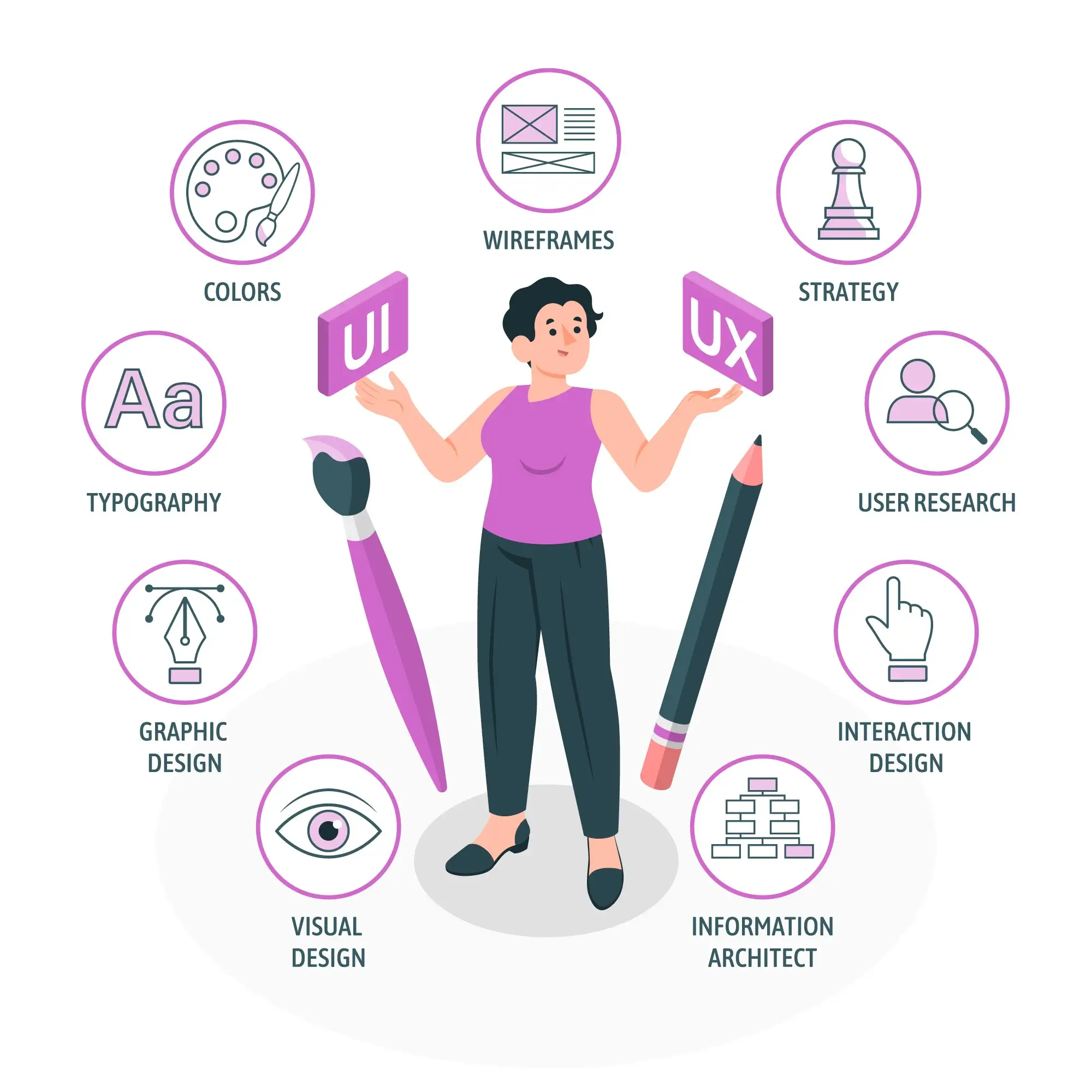User experience (UX) is essential to the success of any product or service in today’s digital world. By taking into account the needs, objectives, and expectations of users, UX design focuses on delivering enjoyable and meaningful experiences for users. UX designers use a methodical methodology with many steps and activities to accomplish this.
This thorough guide will take you step-by-step through the UX design process, covering topics including the value of user research, the usage of design tools like wireframes and prototypes, user testing methodologies, implementation strategies, and more. So let’s get started and discover the UX design process’s mysteries.
UX Design Process Step-by-Step
UX Processes Explained: User Research
User research forms the foundation of the design process in UX. It involves gathering insights about the target users, their behaviors, preferences, and pain points. By understanding the users’ needs, designers can create solutions that cater to them effectively. User research encompasses various methods such as interviews, surveys, and observations. Through these techniques, designers gain valuable information that guides their design decisions.
Why Is User Research So Important?
User research is important because it enables designers to get an understanding of users’ needs and make wise design decisions. They can utilise this information to recognise usability problems and find chances for development by better understanding the context in which users engage with the good or service. User research may help designers build products that really speak to their intended market by being incorporated into the design process in ux.
Why Do We Conduct User Research First?
Conducting user research at the beginning of the design process in UX process allows designers to gather essential insights early on. By understanding the users’ needs and goals upfront, designers can avoid costly mistakes and ensure that the final product meets the users’ expectations. Starting with user research sets the stage for a user-centered design approach throughout the entire process.
What Is Involved in User Research?
User research involves several key activities. These include:
User Interviews:
interacting directly with people to learn more about their goals, habits, and pain points.
Surveys:
Gather quantitative information from a bigger sample size to learn more about the preferences, demographics, and usage habits of the user base.
Observation and Ethnographic Research:
Observing users in their natural environment to understand their behaviors and uncover unmet needs.
Competitor Analysis:
Analyzing competitors’ products or services to identify strengths, weaknesses, and opportunities for differentiation.
By combining these research methods, designers can gain a comprehensive understanding of their target users and make informed design decisions.
Design: Wireframing and Prototyping
Once designers have gathered insights through user research, they move on to the design phase. Wireframing and prototyping are crucial steps in this process.
What Is Wireframing?
Wireframing involves creating visual representations of the product’s structure and layout. These low-fidelity sketches or digital mockups outline the placement of elements, such as buttons, forms, and text, without focusing on aesthetics. Wireframes provide a blueprint for the user interface and help stakeholders visualize the product’s overall structure.
What Is Prototyping?
Prototyping takes the wireframes to the next level by adding interactivity and functionality. Prototypes are interactive representations of the final product, allowing users to experience its flow and interactions. By testing prototypes with users, designers can gather feedback and refine the design before moving forward. Prototyping helps identify usability issues and allows for iteration and improvement.
User Testing
User testing is a critical step in the UX design process. It involves evaluating the product’s usability by observing how real users interact with it. User testing helps identify pain points, navigation issues, and areas for improvement.
How Does User Testing Work?
User testing typically involves the following steps:
Test Planning:
Defining the objectives, tasks, and scenarios for users to perform during the test.
Recruitment:
Select a representative group of users who match the product’s target audience.
Test Execution:
Observing users as they interact with the product and collecting feedback through various methods such as think-aloud protocol, surveys, or eye-tracking.
Analysis and Iteration:
examining the information gathered during the user testing, detecting usability issues, and making design adjustments in light of the results.
User testing provides valuable insights into how users perceive and interact with the product. It helps designers create more intuitive and user-friendly experiences.
Implementation
After refining the design based on user feedback, the next step is implementation. This involves translating the finalized design into a functional product or service. Development teams collaborate with UX designers to ensure that the design vision is accurately realized.
During implementation, designers work closely with developers, providing guidance and clarifying design specifications. In order to retain the integrity of the user experience during the development phase, effective communication and collaboration are crucial.
FAQs (Frequently Asked Questions)
Q: What role does user research play in the UX design process?
A: The UX design approach is built on user research. It aids in understanding user demands, behaviours, and pain areas so that designers may effectively produce solutions that meet their needs.
Q: Why is wireframing important in UX design?
A: Wireframing allows designers to create a visual blueprint of the product’s structure and layout. It helps stakeholders visualize the overall design and provides a framework for subsequent design iterations.
Q: How can user testing benefit the UX design process?
A: User testing allows designers to observe how real users interact with the product and gather valuable feedback. It helps identify usability issues, refine the design, and create more intuitive user experiences.
Q: What is the significance of prototyping in the UX design process?
A: Users can experience the flow and interactions of the product thanks to the functionality and interactivity that prototyping provides to the design. By testing prototypes with users, designers can gather feedback and make design improvements before the final implementation.
Q: How does the UX design process contribute to the success of a product?
A: The user-centeredness and target market satisfaction of products are ensured through the UX design process. Designers may produce extraordinary experiences that boost user engagement and pleasure by employing a methodical approach.
Q: What is the ultimate goal of the UX design process?
A: Creating meaningful and enjoyable user experiences is the ultimate goal of the UX design process. Designers can create products that genuinely resonate with people and provide the best experiences by taking into account their wants, motivations, and pain areas.
Wireframing & Prototyping Tools:
- Figma (Free Plan) – Cloud-based UI/UX design and prototyping tool.
🔗 https://www.figma.com - Adobe XD (Free Starter Plan) – A powerful UX design tool for wireframing and prototyping.
🔗 https://www.adobe.com/products/xd.html - Balsamiq (Free Trial) – Create low-fidelity wireframes quickly.
🔗 https://balsamiq.com




